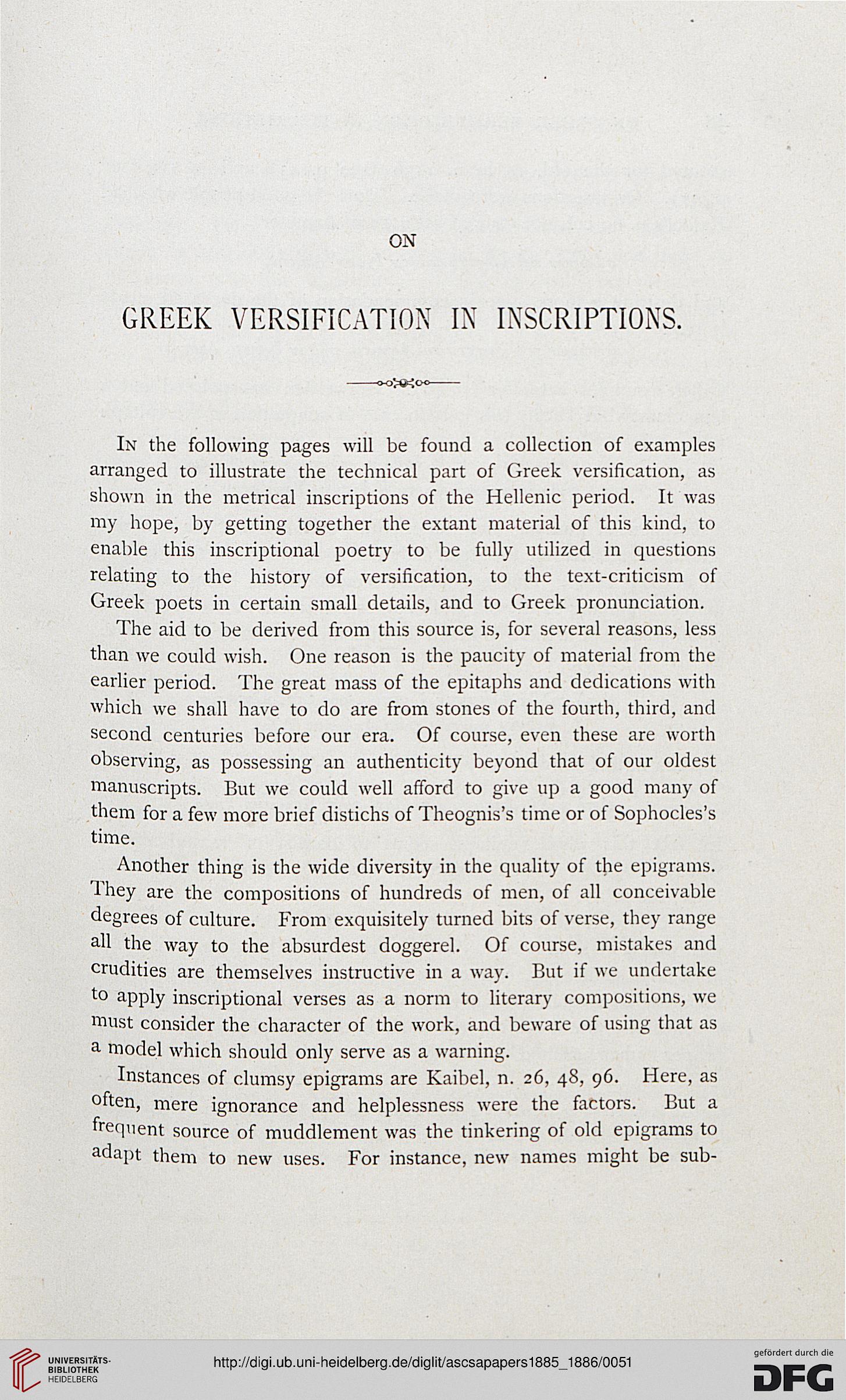ON
GREEK VERSIFICATION IN INSCRIPTIONS.
In the following pages will be found a collection of examples
arranged to illustrate the technical part of Greek versification, as
shown in the metrical inscriptions of the Hellenic period. It was
my hope, by getting together the extant material of this kind, to
enable this inscriptional poetry to be fully utilized in questions
relating to the history of versification, to the text-criticism of
Greek poets in certain small details, and to Greek pronunciation.
The aid to be derived from this source is, for several reasons, less
than we could wish. One reason is the paucity of material from the
earlier period. The great mass of the epitaphs and dedications with
which we shall have to do are from stones of the fourth, third, and
second centuries before our era. Of course, even these are worth
observing, as possessing an authenticity beyond that of our oldest
manuscripts. But we could well afford to give up a good many of
them for a few more brief distichs of Theognis's time or of Sophocles's
time.
Another thing is the wide diversity in the quality of the epigrams.
They are the compositions of hundreds of men, of all conceivable
degrees of culture. From exquisitely turned bits of verse, they range
all the way to the absurdest doggerel. Of course, mistakes and
crudities are themselves instructive in a way. But if we undertake
to apply inscriptional verses as a norm to literary compositions, we
must consider the character of the work, and beware of using that as
a model which should only serve as a warning.
Instances of clumsy epigrams are Kaibel, n. 26, 48, 96. Here, as
often, mere ignorance and helplessness were the factors. But a
frequent source of muddlement was the tinkering of old epigrams to
adapt them to new uses. For instance, new names might be sub-
GREEK VERSIFICATION IN INSCRIPTIONS.
In the following pages will be found a collection of examples
arranged to illustrate the technical part of Greek versification, as
shown in the metrical inscriptions of the Hellenic period. It was
my hope, by getting together the extant material of this kind, to
enable this inscriptional poetry to be fully utilized in questions
relating to the history of versification, to the text-criticism of
Greek poets in certain small details, and to Greek pronunciation.
The aid to be derived from this source is, for several reasons, less
than we could wish. One reason is the paucity of material from the
earlier period. The great mass of the epitaphs and dedications with
which we shall have to do are from stones of the fourth, third, and
second centuries before our era. Of course, even these are worth
observing, as possessing an authenticity beyond that of our oldest
manuscripts. But we could well afford to give up a good many of
them for a few more brief distichs of Theognis's time or of Sophocles's
time.
Another thing is the wide diversity in the quality of the epigrams.
They are the compositions of hundreds of men, of all conceivable
degrees of culture. From exquisitely turned bits of verse, they range
all the way to the absurdest doggerel. Of course, mistakes and
crudities are themselves instructive in a way. But if we undertake
to apply inscriptional verses as a norm to literary compositions, we
must consider the character of the work, and beware of using that as
a model which should only serve as a warning.
Instances of clumsy epigrams are Kaibel, n. 26, 48, 96. Here, as
often, mere ignorance and helplessness were the factors. But a
frequent source of muddlement was the tinkering of old epigrams to
adapt them to new uses. For instance, new names might be sub-




